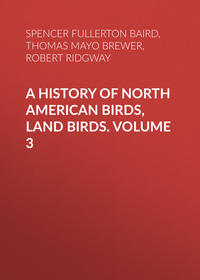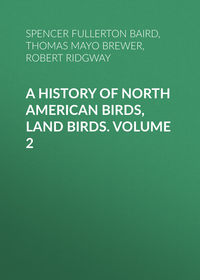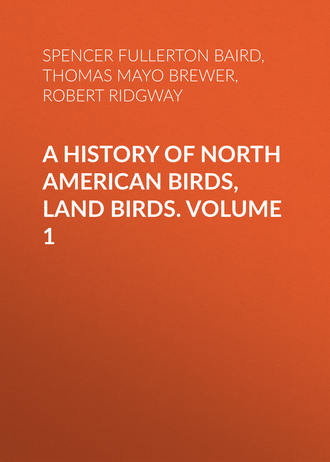 полная версия
полная версияA History of North American Birds, Land Birds. Volume 1
Hab. Whole of North America as far north as Lake Winnipeg and Hudson’s Bay, south branch of Saskatchewan, latitude 52½° (Richardson); south to Guatemala; Jamaica and Cuba in winter.
A specimen from Guatemala (No. 50,455 ♂) is almost identical with examples from the United States, but differs in having a small spot of yellow at the tip of each primary; also there are red appendages on the tip of a few tail-feathers, as well as the longest feather of the lower tail-coverts. The colors, generally, are softer, the brown more purplish, and the ash finer and more bluish, than in a fine spring male from Washington, D. C.
A specimen (No. 53,396 ♂, Humboldt River, Nevada, September 10, 1868, C. King, R. Ridgway) from the Middle Province of the United States, differs considerably from any other in the collection. The colors are much paler, the anterior portions being almost ochraceous, the whole abdomen nearly white. The white band across the forehead is very broad; the extreme point of the chin only black. Whether it is a representative of a style peculiar to the Great Basin, or merely a bleached individual, cannot be decided without additional specimens from the same region.
There is so much variation in different specimens in regard to the red wax-like appendages, that the Guatemalan specimen mentioned above can hardly be considered as more than a very highly developed individual.
Habits. The habits of the common Cedar-Bird are eminently nomadic, and, so far as those of the Waxwing are known, correspond in all respects, except in the more general and especially the more southern distribution of the present species. They are found throughout North America at least so far as the wooded country extends, and they breed from Florida to the Red River country. They are a common bird in New England, and would be much more so but that their fondness for cherries and other small fruits, and their indifference to danger, makes them an easy and frequent mark for destruction. Their unpopularity has caused their numbers to be greatly reduced of late years in the thickly settled portions of the country.
In Southern Texas Mr. Dresser found these birds very common during the winter at San Antonio and Eagle Pass, but he observed none later than the middle of April. They were seen in Tamaulipas, by Lieutenant Couch, in March, and afterwards in April at New Leon, Mexico. Sumichrast states that these birds are found everywhere and in great abundance in winter throughout Vera Cruz. They are there known as the Chinito, and are highly appreciated by the Mexican epicures. They are equally abundant in northern parts of South America, and also throughout Central America.
In Washington Territory and in Oregon Dr. Cooper speaks of them as less common than in the Atlantic States, and he only met with a few, in single pairs, in the summer. Townsend states that he found them in Oregon, but Dr. Suckley never met with any west of the Rocky Mountains.
In California Dr. Cooper has seen small flocks in winter, as far south as San Diego, feeding on the mistletoe berries. He found their nests at Fort Vancouver, and has no doubt that they also breed in various parts of California.
Mr. Robert Kennicott states, among other memoranda of his route, that, May 31, on an island in Winnipeg River, he saw a large flock of these birds, numbering fifty or more.
With some irregularity as to their appearance, they are found throughout the year in New England, their presence being usually regulated by their food. They are, by preference, eaters of berries and other vegetable food, except in spring and early summer, when they eat insects almost exclusively, feeding upon the larvæ of the spanworm and the canker-worm, and small caterpillars, and supplying these to their young. They also feed their nestlings with various kinds of berries and small fruits, both cultivated and wild. They do not nest until late in June or early in July, and with so much irregularity that I have found them sitting on their unhatched eggs as late as the 12th of October. They are a greedy bird, feeding voraciously where they have an opportunity. They are very much attached to each other and to their offspring. Once, when one had been taken in a net spread over strawberries, its mate refused to leave it, suffered itself to be taken by the hand, in its anxiety to free its mate, and when set at liberty would not leave until its mate had also been released and permitted to go with it. In the summer of 1870 a nestling, hardly half fledged, fell from its nest, and was found injured by its fall, taken into the house, and fed. Whenever exposed in its cage its parents came about it, and supplied it with cherries and other fruit, unmindful of the near presence of the family. The young bird lived, and became perfectly tame, feeding from the hand, and preferring to be fed rather than feed itself. Besides its low lisping call, this bird had a regular faint attempt at a song of several low notes, uttered in so low a tone that it would be almost inaudible at even a short distance. It became perfectly contented in confinement, and appeared fond of such members of the family as noticed it.
The noticeable feature of the Cedar-Bird, its crest, it has the power to erect or depress at will. In confinement it generally keeps this depressed, only erecting it when excited from any cause, such as alarm, or desire to receive food.
Wilson states that in Pennsylvania they collect in August in large flocks and retire to the mountains, feeding on the fruit of the Vaccinium uliginosum, which grows there in great abundance. Later in the season they descend to the lowlands to feed on the berries of the sour-gum and the red-cedar. In confinement they are very fond of apples, bread soaked in milk, and almost any kind of soft food. They are also very fond of flies, and are expert flycatchers, snapping at all that venture within the cage.
In their migrations their flight is graceful, easy, and continued, and is performed at a considerable height.
It is unfortunate for the horticulturist that this bird has done so much to merit his prejudices and reprobation, and that he does not appreciate to the full the immense services it renders to him each spring in the destruction of injurious insects. A flock of these birds will, in a short space of time, devour an immense number of the larvæ of the destructive canker-worms (Phalænæ) that infest the apples and elms of Massachusetts, and, if permitted, would soon greatly reduce their numbers. But these prejudices cannot be softened by their good deeds, and the Cherry-Bird is still hunted and destroyed.
Their nests are usually constructed late in June or early in July, and are placed in various positions, sometimes in a low bush or tree not more than three or four feet from the ground, and rarely more than twenty. Their nests are large and bulky, but strongly made of various materials. Generally they build a strong external framework, six or seven inches in diameter, composed of the ends of twigs, coarse stems of vegetables, and grasses. Within this they build a compact, well-made fabric of grasses, grapevine bark, and other finer substances, lining the whole with leaves and fine root-fibres. The cavity is large and deep for the bird. The parents are fourteen days in incubating before the young are hatched out, and all this while are remarkably silent, hardly uttering a sound, even their faintest lisping note, when the nest is meddled with, though they evince great anxiety by their fearless indifference to their own danger.
The eggs, usually five, sometimes six, in number, have a marked resemblance to those of the Waxwing, but are smaller. Their ground-color varies from a light slate-color to a deep shade of stone-color, tinged with olive. These are marked with blotches of a dark purplish-brown, almost black, lighter shades of a dark purple, and penumbræ of faint purple, sometimes by themselves or surrounding and continuing the darker spots. They vary in length from .80 to .88 of an inch, and average about .85. In breadth they are from .60 to .70 of an inch, and in shape they differ also from an oblong-oval to one of a quite rounded form.
Nests of these birds from the Arctic regions are more elaborately built and more warmly lined, being often largely made up of the fine dark-colored lichens that cover the forest trees of those regions.
Subfamily PTILOGONATINÆ
Char. Legs moderate. Nostrils oval, with wide naked membrane above and to some extent behind them; the frontal feathers not reaching to their border, and rather soft. Wings graduated, shorter than the somewhat broad, fan-shaped tail; the first quill nearly half the second. Adults plain.
Although we find it convenient for the present to retain the genera Ptilogonys and Myiadestes in the same subfamily, there seems little doubt that they belong to very different families, the latter being more properly placed in Turdidæ, as shown in Rev. Am. Birds. It is not necessary that the subject be discussed here, however, and we merely give the diagnosis of the two groups of which these genera are the types respectively:—
Ptilogonateæ. Tarsi scutellate anteriorly; not longer than middle toe and claw.
Myiadesteæ. Tarsi with a continuous plate anteriorly; longer than middle toe and claw.
Section PTILOGONATEÆChar. Tarsus stout, shorter, or not longer than the middle toe and claw; conspicuously scutellate anteriorly, and frequently on one or other or on both sides; sometimes with a row of small plates behind. Wings much graduated; the second quill not longer than secondaries. Outline of lateral tail-feathers parallel or widening from base to near tip. Tail unvaried, or else inornate at end. Quills without light patch at base. Head crested. Young birds not spotted. Not conspicuous for song.
There are two genera of this section having in brief the following characters:—
Crest narrow, pointed, its feathers stiff, their webs compact; outer primaries broad. Tail rounded … Phænopepla.
Crest broad, decumbent, soft, the feathers loose; outer primaries attenuated. Tail even or cuneate … Ptilogonys.
The genus Ptilogonys has two species, one Mexican, the other Costa-Rican, neither coming within the limits of the United States. The type is P. cinereus, Swainson (Baird, Rev. Am. Birds, 412), a species of the tablelands of Mexico, which may yet be found within the southern borders of the United States in New Mexico or Arizona.
Genus PHÆNOPEPLA, SclaterPhænopepla, Sclater, P. Z. S. 1858, 543. (Type, Ptiliogonys nitens, Swains.)
Gen. Char. Crest narrow, pointed behind. Outer primaries broad, not attenuated nor pointed at end; the first half the second. Tail rounded, fan-shaped; feathers very broad, wider towards end. Bill feeble, rather narrow, well bristled; nostrils somewhat overhung by frontal feathers. Sexes dissimilar; male black; quills with median white patch on inner webs; tail not varied.
The single known species is glossy black in the male; the female brownish-ash.
Phænopepla nitens, SclaterSHINING-CRESTED FLYCATCHERPtiliogonys nitens, Sw. An. in Menag. 1838, 285.—Bon. Consp. 1850, 335.—Heermann, Jour. A. N. Sc. Phila. II, 1853, 263.—Cassin, Ill. Birds Texas, etc. 1854, 169, pl. xxix. Cichlopsis nitens, Baird, Birds N. Am. 1858, 320, 923. Phænopepla nitens, Sclater, P. Z. S. 1858, 543; 1864, 173 (City of Mexico).—Baird, Rev. Am. B. 1864, 416.—Cooper, Orn. Cal. 1, 1870, 131. “Lepturus galeatus, Less.”
Sp. Char. (No. 8,275 ♂.) Tail broad, almost fan-shaped; graduated slightly; not at all emarginate, and longer than wing. First quill broad, slightly falcate, scarcely attenuated; more than half the second, which about equals the tenth; sixth longest; third equal to seventh. Feathers on nape rather full, with a lengthened, pointed, narrow, occipital crest.
Male (No. 8,275) entirely glossy greenish-black; the inner webs of all the primary quills with a large, lengthened patch of white, which does not reach the inner margin; their outer webs very narrowly edged with ashy, as are also lateral tail-feathers externally.
Female (No. 8,274) brownish-ash, paler below; the white of inner webs of quills obsolete; the greater coverts and quills edged externally with whitish, the anal and crissal feathers edged and tipped with the same; the outer tail-feather with narrow edge of white externally towards end.
Immature birds show every gradation of color between the two extremes described above.
Total length, 7.60; wing, 3.80; tail, 4.35; length of bill from forehead, .46, from nostril .31, along gape, .66; tarsus, .70; middle toe and claw, .65.

Phænopepla nitens.
8275
Hab. Mountainous region of the southern portions of Western and Middle Provinces of United States, and south to Orizaba; Cape St. Lucas; Plateau of Mexico (resident, Sumichrast).
Habits. So far as known, this bird occurs in the mountainous portions of the United States, from Fort Tejon, Cal., to Mexico, and from the Rio Grande to San Diego. It is closely allied, in its appearance, as also in many of its habits, both with the Waxwings and the Flycatchers.
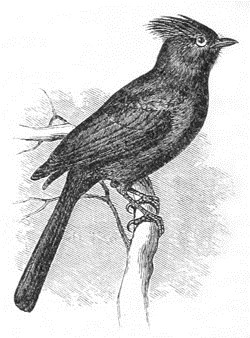
Phænopepla nitens.
This species was first detected within the United States by Colonel McCall, who obtained it in California in 1852. Its habits, as he observed them, partook of those of the true Flycatcher. They are said to be remarkable for their slender, active form, in which their long and ample tail, and the elongated feathers of their head, capable of being erected into a crest, are conspicuous features. Colonel McCall first met with them in a clump of trees on the borders of a mountain brook, between Valliecita and El Chino. A number of them were together actively engaged in the pursuit of insects. They were light and graceful on the wing, though less swift and decided in their motions than the true Flycatchers. In these evolutions the bright white spot on the wing, visible only when the wing is spread, was quite conspicuous, and in fine contrast with the glossy black of the general plumage. In his journey Colonel McCall afterwards met this bird several times, either in small companies or singly. They were always either on mountain sides, or in the timbered borders of mountain streams.
Dr. Henry met with this species near the Little Lagoon, on the Colorado Desert. It was perched on a mezquite-tree, jerking its tail almost incessantly, as do other kinds of Flycatchers, and, from time to time, dashing in irregular curves high into the air in pursuit of insects. It became quite abundant as he approached the Colorado, occurring in companies of twenty and thirty. At Fort Yuma he also met with them in considerable numbers late in November, as they were migrating southward. Dr. Henry describes its note as a low, plaintive whistle. He ascertained that it breeds in California by finding specimens of young birds. He likewise met with this species near Fort Webster, in New Mexico; and Dr. Kennerly also noticed it, in February and March, between Big Sandy Creek and the Colorado River.
Mr. Dresser obtained two specimens of this species at Eagle Pass. One of these had its stomach filled with the berries of a species of mistletoe that grows abundantly on the mezquite-trees. He noticed that it carries its crest erect and much recurved, after the manner of the European Parus cristatus.
Sumichrast states that this species, called Reyecito, is well distributed throughout the Plateau of Mexico, but only ranges in the valley of the Orizaba, to the height of about 1,500 metres, rarely coming as far as that. It is also common at Tehauntepec and other places.
Dr. Cooper found them quite numerous, in winter, near the Colorado. He also found them common, in December, about the Mohave River, and in summer, from Los Angeles to San Diego. They were found to prefer the trees in which the mistletoe grows, on the berries of which they largely feed, though they occasionally pursue insects in a zigzag course similar to that of the Sayornis nigricans.
They almost constantly utter a loud cry of alarm, and when pursued are very wild. When wounded, they conceal themselves so closely in the thick tufts of the mistletoe as to be found with difficulty. Many left the Colorado Valley in April, but a few remained. Their notes Dr. Cooper describes as similar to those of the Crested Flycatchers, but sweeter.
It was found by Feilner, at Fort Crook, in April, 1860, but has not been met with near the coast so far to the north.
A nest of this bird, obtained by Dr. Cooper, on the 27th of April, was built on a horizontal branch of the mezquite (Algarobia), twelve feet from the ground. It was found near Fort Mohave, on the Colorado River. The nest is a very flat structure, four inches in diameter, and less than two in height. The cavity is less than an inch in depth. The nest is made almost entirely of hempen or flax-like fibres of plants, interwoven with fine grasses, stems of plants, and stalks of a larger size. It is lined with a soft downy substance of a vegetable character.
The eggs, two in number, are of an oblong-oval shape, nearly equal at either end, and with a ground-color of a light slate, tinged with a yellowish-green. They are marked and blotched equally over the entire egg, with spots and blotches of various lines, from a light, faint, obscure purple to deeper tints of purplish-brown, even to black. It is a very marked egg, and unique in its appearance. They measure .90 by .60 of an inch.
Dr. Coues found this species a summer resident in Arizona, somewhat rare about Fort Whipple, but found very abundantly a little farther south, and a permanent resident in the southern portions of that Territory. It inhabits rather open country in preference to densely wooded regions. He describes it as a shy, wild, and restless bird, with a superb song, powerful and finely modulated. Dr. Coues appears to think that this species has but little affinity with the forms with which it is usually grouped.
Section MYIADESTEÆChar. Tarsus slender, longer than middle toe and claw; undivided as in Turdidæ. Toes deeply cleft. Wings more pointed; second quill much longer than secondaries. Lateral tail-feathers cuneate, or narrowing from base towards tip; generally whitish at end of inner web. Quills with their extreme bases, especially of inner webs, buffy yellow, showing a light patch inside. Head not crested, though the feathers sometimes full. In the young all the feathers with light rounded spots. Pre-eminent as melodious singers.
But a single genus of this group belongs to the United States, although two others (Cichlopsis and Platycichla?) occur in South America. As already stated, the affinities of Myiadesteæ are much closest to Turdidæ, and this would seem the proper family for it.
Genus MYIADESTES, SwainsonMyiadestes, Swainson, Jard. Nat. Library, XIII. Flycatchers, “1838,” 132. (Type, M. genibarbis, Sw.)
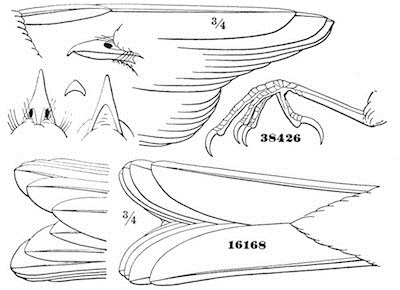
Myiadestes townsendi
38426
16168
Gen. Char. Occipital feathers full and soft. Plumage rather loose. Bill weak, much depressed. Commissure nearly straight. Hind toe longer than inner lateral. Toes deeply cleft. Closed wing externally with an exposed light band across the base of the quills, and another nearer the end, separated by a darker one. Tail somewhat graduated on the sides.
Of the ten or more described species of this genus, only one belongs to the limits of the United States, although several others occupy adjacent territory in Mexico. Several are peculiar to islands of the West Indies.
The only two species closely related to the M. townsendi are the M. unicolor and M. obscurus, which belong to Mexico. They may be distinguished as follows:—
An ochraceous band across base of secondaries and upper primaries, conspicuous on outer surface.
1. M. townsendi. Generally dull ashy, paler beneath. Throat and abdomen whitish. Hab. Middle and Pacific Provinces of United States only.
No ochraceous on outer webs of secondaries and primaries.
2. M. obscurus.80 Back and wings rusty-olive. Head and beneath ashy, top of head deepest ash. Hab. Mountains of Mexico and Guatemala; Tres Marias Islands.
3. M. unicolor.81 Entirely dark bluish slate-color, lighter beneath. Lores black. Hab. Central Mexico and Guatemala.
Myiadestes townsendi, CabanTOWNSEND’S SOLITAIREPtiliogonys townsendi, Aud. Orn. Biog. V, 1839, 206, pl. ccccxix, fig. 2. (For other references see Birds N. Am. 321.)—Newberry, P. R. Rep. VI, Whipple’s Rep. Zoöl., 82. Culicivora towns. De Kay, N. Y. Zoöl. II, 1844, 110. Myiadestes towns. Cabanis, Wieg. Arch. 1847, I, 208.—Sclater, P. Z. S. 1857, 5; 1858, 97.—Baird, Birds N. Am. 1858, 321; Rev. 429.—Cooper & Suckley, P. R. Rep. XII, II, 187.—Kennerly, P. R. Rep. X, Whipple’s Rep. 25.—Lord, Pr. R. Art. Inst. Woolwich, IV, 116 (Br. Col.).—Cooper, Orn. Cal. 1, 1870, 134.
Sp. Char. Tail rather deeply forked. Exposed portion of spurious quill less than one third that of the second; fourth quill longest; second a little longer than the sixth. Head not crested. General color bluish-ash, paler beneath; under wing-coverts white. Quills with a brownish-yellow bar at the base of both webs mostly concealed, but showing a little below the greater coverts and alulæ; this succeeded by a bar of dusky, and next to it another of brownish-yellow across the outer webs of the central quills only. Tertials tipped with white. Tail-feathers dark brown; the middle ones more like the back; the lateral with the outer web and tip, the second with the tip only, white. A white ring round the eye. Length, 8 inches; wing, 4.50; tail, 3.85. (8,234).
Hab. Mountainous regions of Middle and Western United States. (Not found at Cape St. Lucas nor in Mexico.)
Young birds have a large triangular pale-ochraceous light spot on the end of each feather (rather paler below), bounded externally by a narrow border of blackish; the quill and tail feathers as in the adult.
Habits. The first specimen of this somewhat remarkable bird was shot by Captain Brotchie, at Fort George, Astoria, and presented to Mr. Townsend, and by the latter given to Mr. Audubon. For some time this remained unique, and the habits of the species unknown. Through the government explorations, however, we have been made more familiar with its habits and peculiarities.
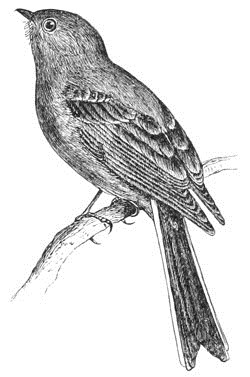
Myiadestes townsendi.
Dr. Newberry, in his report on the Zoölogy of Lieutenant Williamson’s explorations, mentions finding this bird very abundant in the Des Chutes Basin. It did not frequent either dense forests or prairies destitute of trees, but seemed to select surfaces covered with a scattered growth of pine and cedar. His party first met with it at the base of Mount Jefferson, in the cañon of Mpto-ly-as River. In picking his way with infinite difficulty down this gorge, his attention was drawn by its new and attractive song. There were several of them in the pines and cedars growing on the face of the cliff. He describes its song as clear, full, and melodious, like that of a true Mimus. The next day, as he followed down the river, in the bottom of the cañon the deep gorge was filled with a chorus of sweet sounds from thousands of these birds. He describes them as having a habit of sitting on the branch of a tree projecting over a stream, or hanging from some projecting crag, and at times flying out in narrow circles, after insects, precisely in the manner of Flycatchers.
Afterwards, in another cañon, the terraced banks of which were sparsely set with low trees of the Western cedar, he again found these birds quite numerous, and had every opportunity both of hearing and of seeing them, watching them for hours while feeding and singing. They began their songs with the first dawn of day, and at sunrise the valley was perfectly vocal with their music. He describes their song as not greatly varied, but speaks of all their notes as particularly clear and sweet, and with strains of pure gushing melody that were both spontaneous and inspiring. At that time, September 30, they were feeding on the berries of the cedar. They were very shy, and could only be obtained by stratagem.




